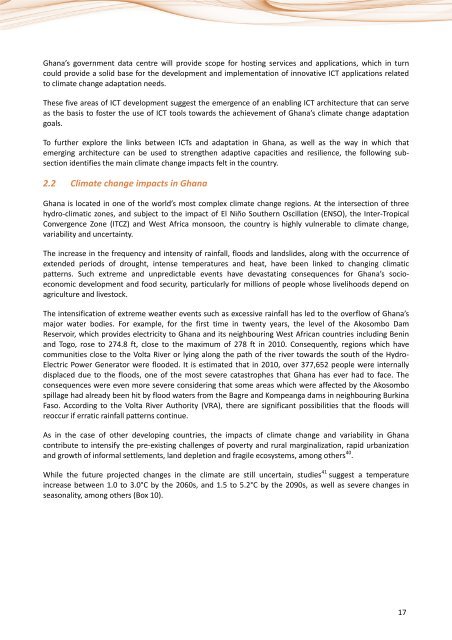Information and communication technologies (ICTs) and ... - ITU
Information and communication technologies (ICTs) and ... - ITU
Information and communication technologies (ICTs) and ... - ITU
Create successful ePaper yourself
Turn your PDF publications into a flip-book with our unique Google optimized e-Paper software.
Ghana’s government data centre will provide scope for hosting services <strong>and</strong> applications, which in turn<br />
could provide a solid base for the development <strong>and</strong> implementation of innovative ICT applications related<br />
to climate change adaptation needs.<br />
These five areas of ICT development suggest the emergence of an enabling ICT architecture that can serve<br />
as the basis to foster the use of ICT tools towards the achievement of Ghana’s climate change adaptation<br />
goals.<br />
To further explore the links between <strong>ICTs</strong> <strong>and</strong> adaptation in Ghana, as well as the way in which that<br />
emerging architecture can be used to strengthen adaptive capacities <strong>and</strong> resilience, the following subsection<br />
identifies the main climate change impacts felt in the country.<br />
2.2 Climate change impacts in Ghana<br />
Ghana is located in one of the world’s most complex climate change regions. At the intersection of three<br />
hydro-climatic zones, <strong>and</strong> subject to the impact of El Niño Southern Oscillation (ENSO), the Inter-Tropical<br />
Convergence Zone (ITCZ) <strong>and</strong> West Africa monsoon, the country is highly vulnerable to climate change,<br />
variability <strong>and</strong> uncertainty.<br />
The increase in the frequency <strong>and</strong> intensity of rainfall, floods <strong>and</strong> l<strong>and</strong>slides, along with the occurrence of<br />
extended periods of drought, intense temperatures <strong>and</strong> heat, have been linked to changing climatic<br />
patterns. Such extreme <strong>and</strong> unpredictable events have devastating consequences for Ghana’s socioeconomic<br />
development <strong>and</strong> food security, particularly for millions of people whose livelihoods depend on<br />
agriculture <strong>and</strong> livestock.<br />
The intensification of extreme weather events such as excessive rainfall has led to the overflow of Ghana’s<br />
major water bodies. For example, for the first time in twenty years, the level of the Akosombo Dam<br />
Reservoir, which provides electricity to Ghana <strong>and</strong> its neighbouring West African countries including Benin<br />
<strong>and</strong> Togo, rose to 274.8 ft, close to the maximum of 278 ft in 2010. Consequently, regions which have<br />
communities close to the Volta River or lying along the path of the river towards the south of the Hydro-<br />
Electric Power Generator were flooded. It is estimated that in 2010, over 377,652 people were internally<br />
displaced due to the floods, one of the most severe catastrophes that Ghana has ever had to face. The<br />
consequences were even more severe considering that some areas which were affected by the Akosombo<br />
spillage had already been hit by flood waters from the Bagre <strong>and</strong> Kompeanga dams in neighbouring Burkina<br />
Faso. According to the Volta River Authority (VRA), there are significant possibilities that the floods will<br />
reoccur if erratic rainfall patterns continue.<br />
As in the case of other developing countries, the impacts of climate change <strong>and</strong> variability in Ghana<br />
contribute to intensify the pre-existing challenges of poverty <strong>and</strong> rural marginalization, rapid urbanization<br />
<strong>and</strong> growth of informal settlements, l<strong>and</strong> depletion <strong>and</strong> fragile ecosystems, among others 40 .<br />
While the future projected changes in the climate are still uncertain, studies 41 suggest a temperature<br />
increase between 1.0 to 3.0°C by the 2060s, <strong>and</strong> 1.5 to 5.2°C by the 2090s, as well as severe changes in<br />
seasonality, among others (Box 10).<br />
17

















